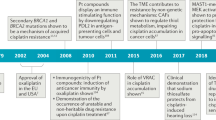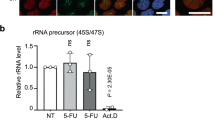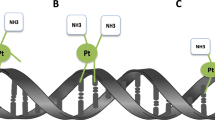Abstract
Cisplatin and its platinum analogs, carboplatin and oxaliplatin, are some of the most widely used cancer chemotherapeutics. Although cisplatin and carboplatin are used primarily in germ cell, breast and lung malignancies, oxaliplatin is instead used almost exclusively to treat colorectal and other gastrointestinal cancers. Here we utilize a unique, multi-platform genetic approach to study the mechanism of action of these clinically established platinum anti-cancer agents, as well as more recently developed cisplatin analogs. We show that oxaliplatin, unlike cisplatin and carboplatin, does not kill cells through the DNA-damage response. Rather, oxaliplatin kills cells by inducing ribosome biogenesis stress. This difference in drug mechanism explains the distinct clinical implementation of oxaliplatin relative to cisplatin, and it might enable mechanistically informed selection of distinct platinum drugs for distinct malignancies. These data highlight the functional diversity of core components of front-line cancer therapy and the potential benefits of applying a mechanism-based rationale to the use of our current arsenal of anti-cancer drugs.
This is a preview of subscription content, access via your institution
Access options
Access Nature and 54 other Nature Portfolio journals
Get Nature+, our best-value online-access subscription
$29.99 / 30 days
cancel any time
Subscribe to this journal
Receive 12 print issues and online access
$209.00 per year
only $17.42 per issue
Buy this article
- Purchase on Springer Link
- Instant access to full article PDF
Prices may be subject to local taxes which are calculated during checkout






Similar content being viewed by others
References
Kelland, L. The resurgence of platinum-based cancer chemotherapy. Nat. Rev. Cancer 7, 573–584 (2007).
Chu, E. & v DeVita Jr, V.T. Physician's Cancer Chemotherapy Drug Manual (Jones & Bartlett Learning Oncology, Sudbury, 2008).
Rixe, O. et al. Oxaliplatin, tetraplatin, cisplatin, and carboplatin: spectrum of activity in drug-resistant cell lines and in the cell lines of the National Cancer Institute's Anticancer Drug Screen panel. Biochem. Pharmacol. 52, 1855–1865 (1996).
Machover, D. et al. Two consecutive phase II studies of oxaliplatin (L-OHP) for treatment of patients with advanced colorectal carcinoma who were resistant to previous treatment with fluoropyrimidines. Ann. Oncol. 7, 95–98 (1996).
Jiang, H., Pritchard, J.R., Williams, R.T., Lauffenburger, D.A. & Hemann, M.T. A mammalian functional-genetic approach to characterizing cancer therapeutics. Nat. Chem. Biol. 7, 92–100 (2011).
Pritchard, J.R. et al. Defining principles of combination drug mechanisms of action. Proc. Natl. Acad. Sci. USA 110, E170–E179 (2013).
Pritchard, J.R., Bruno, P.M., Hemann, M.T. & Lauffenburger, D.A. Predicting cancer drug mechanisms of action using molecular network signatures. Mol. Biosyst. 9, 1604–1619 (2013).
Suntharalingam, K. et al. Bidentate ligands on osmium(VI) nitrido complexes control intracellular targeting and cell death pathways. J. Am. Chem. Soc. 135, 14060–14063 (2013).
Suntharalingam, K. et al. A breast cancer stem cell-selective, mammospheres-potent osmium(VI) nitrido complex. J. Am. Chem. Soc. 136, 14413–14416 (2014).
Suntharalingam, K. et al. Necroptosis-inducing rhenium(V) oxo complexes. J. Am. Chem. Soc. 137, 2967–2974 (2015).
Awuah, S.G., Zheng, Y.-R., Bruno, P.M., Hemann, M.T. & Lippard, S.J.A. Pt(IV) pro-drug preferentially targets indoleamine-2,3-dioxygenase, providing enhanced ovarian cancer immuno-chemotherapy. J. Am. Chem. Soc. 137, 14854–14857 (2015).
Boodram, J.N. et al. Breast cancer stem cell potent copper(II)-non-steroidal anti-inflammatory drug complexes. Angew. Chem. Int. Ed.Engl. 55, 2845–2850 (2016).
Cressey, P.B. et al. The potent inhibitory effect of a naproxen-appended cobalt(III)-cyclam complex on cancer stem cells. ChemBioChem 17, 1713–1718 (2016).
Zheng, Y.-R. et al. Mechanistic studies of the anticancer activity of an octahedral hexanuclear Pt(II) cage. Inorganica Chim. Acta 452, 125–129 (2016).
Barnes, J.C. et al. Using an RNAi signature assay to guide the design of three-drug-conjugated nanoparticles with validated mechanisms, in vivo efficacy, and low toxicity. J. Am. Chem. Soc. 138, 12494–12501 (2016).
Zamble, D.B., Mu, D., Reardon, J.T., Sancar, A. & Lippard, S.J. Repair of cisplatin—DNA adducts by the mammalian excision nuclease. Biochemistry 35, 10004–10013 (1996).
Fojo, T. et al. Identification of non-cross-resistant platinum compounds with novel cytotoxicity profiles using the NCI anticancer drug screen and clustered image map visualizations. Crit. Rev. Oncol. Hematol. 53, 25–34 (2005).
Alvarez, M. et al. Generation of a drug resistance profile by quantitation of mdr-1/P-glycoprotein in the cell lines of the National Cancer Institute Anticancer Drug Screen. J. Clin. Invest. 95, 2205–2214 (1995).
Willett, P., Barnard, J.M. & Downs, G.M. Chemical similarity searching. J. Chem. Inf. Comput. Sci. 38, 983–996 (1998).
Williams, R.T., Roussel, M.F. & Sherr, C.J. Arf gene loss enhances oncogenicity and limits imatinib response in mouse models of Bcr-Abl-induced acute lymphoblastic leukemia. Proc. Natl. Acad. Sci. USA 103, 6688–6693 (2006).
Maede, Y. et al. Differential and common DNA repair pathways for topoisomerase I- and II-targeted drugs in a genetic DT40 repair cell screen panel. Mol. Cancer Ther. 13, 214–220 (2014).
Jiang, H. et al. The combined status of ATM and p53 link tumor development with therapeutic response. Genes Dev. 23, 1895–1909 (2009).
Rogakou, E.P., Nieves-Neira, W., Boon, C., Pommier, Y. & Bonner, W.M. Initiation of DNA fragmentation during apoptosis induces phosphorylation of H2AX histone at serine 139. J. Biol. Chem. 275, 9390–9395 (2000).
Bonner, W.M. et al. GammaH2AX and cancer. Nat. Rev. Cancer 8, 957–967 (2008).
Olive, P.L. & Banáth, J.P. The comet assay: a method to measure DNA damage in individual cells. Nat. Protoc. 1, 23–29 (2006).
Golomb, L., Volarevic, S. & Oren, M. p53 and ribosome biogenesis stress: the essentials. FEBS Lett. 588, 2571–2579 (2014).
Boulon, S., Westman, B.J., Hutten, S., Boisvert, F.M. & Lamond, A.I. The nucleolus under stress. Mol. Cell 40, 216–227 (2010).
Liu, J., Xu, Y., Stoleru, D. & Salic, A. Imaging protein synthesis in cells and tissues with an alkyne analog of puromycin. Proc. Natl. Acad. Sci. USA 109, 413–418 (2012).
Bliss, C.I. The calculation of microbial assays. Bacteriol. Rev. 20, 243–258 (1956).
Reinhold, W.C. et al. CellMiner: a web-based suite of genomic and pharmacologic tools to explore transcript and drug patterns in the NCI-60 cell line set. Cancer Res. 72, 3499–3511 (2012).
Huang, W., Sherman, B.T. & Lempicki, R.A. Bioinformatics enrichment tools: paths toward the comprehensive functional analysis of large gene lists. Nucleic Acids Res. 37, 1–13 (2009).
Huang, W., Sherman, B.T. & Lempicki, R.A. Systematic and integrative analysis of large gene lists using DAVID bioinformatics resources. Nat. Protoc. 4, 44–57 (2009).
Subramanian, A. et al. Gene set enrichment analysis: a knowledge-based approach for interpreting genome-wide expression profiles. Proc. Natl. Acad. Sci. USA 102, 15545–15550 (2005).
Cancer Genome Atlas Research Network. Integrated genomic analyses of ovarian carcinoma. Nature 474, 609–615 (2011).
Muzny, D.M. et al.; Comprehensive molecular characterization of human colon and rectal cancer. Nature 487, 330–337 (2012).
Faller, W.J. et al. mTORC1-mediated translational elongation limits intestinal tumour initiation and growth. Nature 517, 497–500 (2015).
Koboldt, D.C. et al. Comprehensive molecular portraits of human breast tumours. Nature 490, 61–70 (2012).
Raymond, E., Chaney, S.G., Taamma, A. & Cvitkovic, E. Oxaliplatin: a review of preclinical and clinical studies. Ann. Oncol. 9, 1053–1071 (1998).
Raymond, E., Lawrence, R., Izbicka, E., Faivre, S. & Von Hoff, D.D. Activity of oxaliplatin against human tumor colony-forming units. Clin. Cancer Res. 4, 1021–1029 (1998).
Shelley, M.D., Burgon, K. & Mason, M.D. Treatment of testicular germ-cell cancer: a cochrane evidence-based systematic review. Cancer Treat. Rev. 28, 237–253 (2002).
Goldberg, R.M. et al. A randomized controlled trial of fluorouracil plus leucovorin, irinotecan, and oxaliplatin combinations in patients with previously untreated metastatic colorectal cancer. J. Clin. Oncol. 22, 23–30 (2004).
Raez, L.E. et al. Efficacy and safety of oxaliplatin and docetaxel in patients with locally advanced and metastatic non-small-cell lung cancer (NSCLC). Lung Cancer 53, 347–353 (2006).
Atmaca, A. et al. A randomised multicentre phase II study with cisplatin/docetaxel vs oxaliplatin/docetaxel as first-line therapy in patients with advanced or metastatic non-small cell lung cancer. Br. J. Cancer 108, 265–270 (2013).
Scagliotti, G.V. et al. Pemetrexed combined with oxaliplatin or carboplatin as first-line treatment in advanced non-small cell lung cancer: a multicenter, randomized, phase II trial. Clin. Cancer Res. 11, 690–696 (2005).
Yardley, D.A. et al. A phase II trial of oxaliplatin and trastuzumab in the treatment of HER2-positive metastatic breast cancer. Cancer Invest. 28, 865–871 (2010).
Njiaju, U.O. et al. Capecitabine and oxaliplatin in combination as first- or second-line therapy for metastatic breast cancer: a Wisconsin Oncology Network trial. Cancer Chemother. Pharmacol. 71, 613–618 (2013).
Guerrero, A. et al. Phase I/II study of biweekly vinorelbine and oxaliplatin as first-line treatment in patients with metastatic breast cancer. Anticancer Drugs 22, 283–289 (2011).
Imielinski, M. et al. Mapping the hallmarks of lung adenocarcinoma with massively parallel sequencing. Cell 150, 1107–1120 (2012).
Meijers-Heijboer, H. et al. Low-penetrance susceptibility to breast cancer due to CHEK2(*)1100delC in noncarriers of BRCA1 or BRCA2 mutations. Nat. Genet. 31, 55–59 (2002).
Samimi, G. et al. cDNA microarray-based identification of genes and pathways associated with oxaliplatin resistance. Cancer Chemother. Pharmacol. 55, 1–11 (2005).
Kim, M.K. et al. Characterization of an oxaliplatin sensitivity predictor in a preclinical murine model of colorectal cancer. Mol. Cancer Ther. 11, 1500–1509 (2012).
Bertucci, F. et al. Gene expression profiling of colon cancer by DNA microarrays and correlation with histoclinical parameters. Oncogene 23, 1377–1391 (2004).
Arango, D. et al. Gene-expression profiling predicts recurrence in Dukes' C colorectal cancer. Gastroenterology 129, 874–884 (2005).
Barrier, A. et al. Stage II colon cancer prognosis prediction by tumor gene expression profiling. J. Clin. Oncol. 24, 4685–4691 (2006).
Yamasaki, M. et al. The gene expression profile represents the molecular nature of liver metastasis in colorectal cancer. Int. J. Oncol. 30, 129–138 (2007).
Bandrés, E. et al. A gene signature of 8 genes could identify the risk of recurrence and progression in Dukes' B colon cancer patients. Oncol. Rep. 17, 1089–1094 (2007).
Fritzmann, J. et al. A colorectal cancer expression profile that includes transforming growth factor beta inhibitor BAMBI predicts metastatic potential. Gastroenterology 137, 165–175 (2009).
Zoncu, R., Efeyan, A. & Sabatini, D.M. mTOR: from growth signal integration to cancer, diabetes and ageing. Nat. Rev. Mol. Cell Biol. 12, 21–35 (2011).
Voss, M.H. et al. Tumor genetic analyses of patients with metastatic renal cell carcinoma and extended benefit from mTOR inhibitor therapy. Clin. Cancer Res. 20, 1955–1964 (2014).
Spranger, S., Bao, R. & Gajewski, T.F. Melanoma-intrinsic β-catenin signalling prevents anti-tumour immunity. Nature 523, 231–235 (2015).
Woynarowski, J.M. et al. Oxaliplatin-induced damage of cellular DNA. Mol. Pharmacol. 58, 920–927 (2000).
Burger, K. et al. Chemotherapeutic drugs inhibit ribosome biogenesis at various levels. J. Biol. Chem. 285, 12416–12425 (2010).
Dickins, R.A. et al. Probing tumor phenotypes using stable and regulated synthetic microRNA precursors. Nat. Genet. 37, 1289–1295 (2005).
Zuber, J. et al. Toolkit for evaluating genes required for proliferation and survival using tetracycline-regulated RNAi. Nat. Biotechnol. 29, 79–83 (2011).
Zhao, B., Pritchard, J.R., Lauffenburger, D.A. & Hemann, M.T. Addressing genetic tumor heterogeneity through computationally predictive combination therapy. Cancer Discov. 4, 166–174 (2014).
Park, G.Y., Wilson, J.J., Song, Y. & Lippard, S.J. Phenanthriplatin, a monofunctional DNA-binding platinum anticancer drug candidate with unusual potency and cellular activity profile. Proc. Natl. Acad. Sci. USA 109, 11987–11992 (2012).
Robinson, M.D., McCarthy, D.J. & Smyth, G.K. edgeR: a Bioconductor package for differential expression analysis of digital gene expression data. Bioinformatics 26, 139–140 (2010).
Acknowledgements
This work was supported by the Koch Institute Frontier Research Program through the Michael (1957) and Inara Erdei Fund and the Kathy and Curt Marble Cancer Research Fund, by the Koch Institute Support (core) Grant P30-CA14051 from the National Cancer Institute, by National Cancer Institute Grant CA034992 (S.J.L.), by the Integrative Cancer Biology Program grant #U54-CA112967-09 and by the Center of Cancer Research, the Intramural Program of the National Cancer Institute, NIH (Z01 BC006150-19). M.T.H. is the Chang and Eisen Associate Professor of Biology, C.E.K. was supported by award Number T32GM007753 from the National Institute of General Medical Sciences and G.Y.P. was supported by a Misrock Postdoctoral Fellowship. The authors would also like to thank the Koch Institute Swanson Biotechnology Center for technical support, specifically G. Paradis of the Flow Cytometry Core Facility. We thank J. Wilson for providing platinum compounds ([Pt(tfbz)(NH3)2](NO3)) and [Pt(acac)(NH3)2](SO4)0.5) and D. Bartel for advice and discussion regarding translation and ribosome translation experiments. The authors also thank G. Walker, A. Koehler, E. Bent, C. Braun, E. Kreidl and B. Zhao for comments and discussion on the paper and N. Fenouille, H. Criscione and F. Lam for technical assistance. The authors thank S. Takeda and M. Takata (Kyoto University, Japan) for providing us with the mutant DT40 cell lines used in this study. The content is solely the responsibility of the authors and does not necessarily represent the official views of the National Institute of General Medical Sciences or the National Institutes of Health.
Author information
Authors and Affiliations
Contributions
P.M.B., Y.L., G.Y.P., T.J.E., J.R.P., Y.P., S.J.L. and M.T.H. conceived the idea for the research, designed experiments and interpreted data. P.M.B., Y.L. and C.E.K. performed experiments. P.M.B. and Y.L. performed bioinformatic analyses. J.M. performed DT40 sensitivity profiles. T.J.E. performed polysome gradient profiling. P.M.B., S.J.L. and M.T.H. wrote the paper.
Corresponding authors
Ethics declarations
Competing interests
The authors declare no competing financial interests.
Supplementary information
Supplementary Figures and Tables
Supplementary Figures 1–19 and Supplementary Tables 1–10 (PDF 4054 kb)
Rights and permissions
About this article
Cite this article
Bruno, P., Liu, Y., Park, G. et al. A subset of platinum-containing chemotherapeutic agents kills cells by inducing ribosome biogenesis stress. Nat Med 23, 461–471 (2017). https://doi.org/10.1038/nm.4291
Received:
Accepted:
Published:
Issue Date:
DOI: https://doi.org/10.1038/nm.4291
This article is cited by
-
Platinum-based drugs induce phenotypic alterations in nucleoli and Cajal bodies in prostate cancer cells
Cancer Cell International (2024)
-
Mutational signature-based identification of DNA repair deficient gastroesophageal adenocarcinomas for therapeutic targeting
npj Precision Oncology (2024)
-
Arterial chemotherapy for hepatocellular carcinoma in China: consensus recommendations
Hepatology International (2024)
-
Multimodal treatment with curative intent in a germline BRCA2 mutant metastatic ampullary adenocarcinoma: a case report
World Journal of Surgical Oncology (2023)
-
Tumor microenvironment-responsive metal nanotherapeutics for breast cancer chemo-/immunotherapy
NPG Asia Materials (2023)



